11-month-old male presenting with fever and rash
Click Here to Manage Email Alerts
An 11-month-old male presented to the emergency department [ED] complaining of subjective fever and a rash. The history of the chief complaint began about 4 days earlier with the fever. Soon thereafter, a lesion appeared on his upper lip. In the ED, he was diagnosed with impetigo and given a topical antibiotic cream to apply. The rash soon rapidly spread to involve most of his face, and he returned to the ED, from where he was admitted.
His past medical history is positive only for severe eczema. His birth history was by normal vaginal delivery with no history of maternal herpes or other concerns. His growth and development has also been normal. Except for the chief complaint, his review of systems was unremarkable. His immunizations were documented up to date.
The family history is positive for both parents currently having cold sores.
Examination on admission revealed an alert baby with a fever of 103.4º F with normal pulse and respiratory rate. The only abnormal finding was the generalized eczema and the rash on his face and neck as shown in Figures 1–3, and widely scattered lesions on his extremities (Figure 4), consisting of dozens of ulcers, vesicles and pustules.
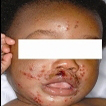 |
 |
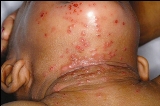 |
|
The only abnormal finding was the generalized eczema and the rash on his face and neck as shown in Figures 1–3. |
||
 The patient also had widely scattered lesions on his extremities. |
What's Your Diagnosis?
- Severe impetigo
- Poison ivy
- Eczema herpeticum
- Shingles
This is a case of eczema herpeticum (C).
The patient was known to have severe eczema, and the lesions are very consistent with cutaneous herpes simplex virus (HSV) infection.
The chronically damaged skin from his eczema offered an ideal medium for the virus to spread until it encounters intact, keratinized epidermis, especially in children whose hands offer frequent assistance. The source of the HSV can be direct contact with an infected person, or the reactivation of one’s own dormant herpes. Since both parents had active cold sores, it may be that this was the source. Regardless of how it got there, these patients should be admitted and treated with IV acyclovir until progression has stopped and lesions begin to crust over, as shown in figure 5 on the third day of hospitalization, which also shows a lesion on the tongue. Continuation of therapy can then be done orally at home with close follow up. The best therapy is always prevention with good skin care management of the eczema.
 The lesions of eczema herpeticum begin to crust over after treatment with IV acyclovir. |
This condition is also known as Kaposi varicelliform eruption, after Moritz Kaposi (1837–1902), an Austrian dermatologist. Interestingly, he also described the Kaposi Sarcoma, also caused by a herpesvirus (Human Herpesvirus 8).
The worst impetigo is not likely to be quite this bad. The lesions are also different, with impetigo having the usual honey-colored crusted lesions, as shown in figure 6 (from the collection of COL Bill Parry, Retired), rather than vesicular/ulcerative lesions. Impetigo is usually an uncomplicated infection caused by either group A Streptococcusor Staph aureus, but may occasionally be complicated by being caused by an Epidermolytic toxin-producing Staphylococcus aureus, resulting in Bullous impetigo (Figure 7 from the Jim Bass collection). However, the treatment is the same; an appropriate oral antibiotic. I might suggest clindamycin, which will treat both staph and strep most of the time.
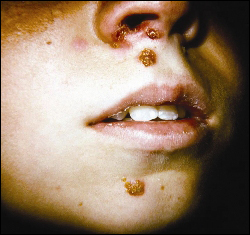 |
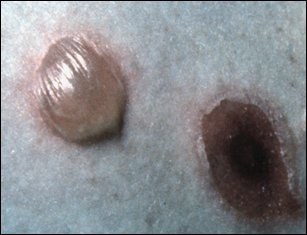 |
|
Impetigo lesions are usually usual honey-colored and crusted. |
Bulbous impetigo (infected with S. aureus). |
However, simple impetigo can usually be treated with just good hygiene and perhaps a topical antibiotic.

Vice Chair for Education at The Children’s Hospital at Scott
and White and Associate Professor of Pediatrics at Texas A&M University,
College of Medicine, Temple, Texas. E-mail: jhbrien@aol.com.
e-mail:jhbrien@aol.com
It would be very unusual for an infant to have contact dermatitis due to poison ivy since they are not likely to get in contact with the plant at this age, and even if they did, it takes a sensitizing contact followed by a second contact to see the manifestations, which is generally a combination of swelling with erythema and vesicles/blisters, occasionally with areas of "streaking" (Figure 8). Involvement of the face is usually accompanied by significant swelling as shown in Figure 9, often mistaken for cellulitis. Treatment is usually a topical and occasionally systemic steroids, depending on the severity.
 Poison ivy exposure typically presents as a combination of swelling with erythema and vesicles/blisters, occasionally with areas of “streaking.” |
 Poison ivy exposure on the face is often confused with cellulitis. |
Shingles may have identical appearing lesions. They are typically seen in a dermatomal distribution, but can be in patches similar to cutaneous herpes. However, since it takes a primary infection with varicella zoster virus, shingles is very uncommon in infants. When shingles is seen in an infant, it is likely to be a result of a primary infection in utero (Figure 10 from Col Tom Murphy, USAF, Retired). Like shingles in older patients, treatment is with acyclovir, but must be started within the first 48 hours to expect any benefit.
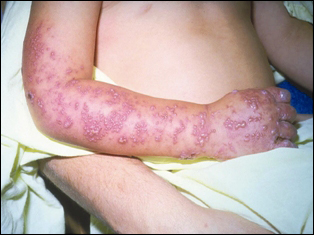 Shingles is uncommon in infants, and likely to be a result of a primary infection of varicella zoster virus in utero. |
Columnist comments
In the July issue, I confessed to my lackluster academic record and background, making the point that without the help of fellow residents and staff, I would likely be doing something else. I gave special credit to an old friend and upper-level resident, who had just died, Dick Eckert for helping to pull me through my PL-1 year. I have been writing this column for 21 years and have never received as much reader feedback as I did after that July issue came out. It seems that many of you have found yourselves in a similar situation. The only picture I have of Dick Eckert (far left in Figure 11) is shown with Jim Bowen (my other upper-level hero) and me in 1983 at the Uniformed Services Pediatric Seminar. By this time, I was already in my first year of fellowship. These were the guys who, as second and third-year residents, took the time to remediate me, under the guidance of Colonel Jim Shira, our department Chief (Chairman). I hope those of you who experienced similar problems had colleagues like these to help you through your tough times of residency.
 (Shown left to right) Dick Eckert, Jim Bowen, and James H. Brien. |
When I was an upper-level resident, I never had the need to help remediate a PL-1 because all those who came after me in those years were very bright and capable; so much so that I worked extra hard to just stay out of their way. On the other hand, I have been in the position as staff a few times over the last 30 years to help a struggling resident; whether suffering from a lack of organizational skills, a weak fund of knowledge or simply unsure of him or herself. Nowadays, I worry that the pressure of meeting productivity goals will erode this aspect of our profession. When I feel myself thinking that way, I go back to the original Hippocratic Oath, and re-read it. It is a bit like having a medical integrity tune-up; bringing back into focus what is important. Why not try it right now?
